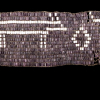The Jesuit Missionary Belt
The Jesuit Missionary Belt
The Jesuit Missionary Belt







A loom woven wampum belt, From the Huron (Wendat) Confederacy, made between 1639-1649. Called "The Jesuit Missionary Belt." Collected by Mr. Horatio Hale from Chief Joseph White while at the Anderdon Reserve between 1872 and 1874. Purchased from Hale by Professor Edward Burnett Tylor, who then donated the belt to the Pitt Rivers Museum in 1896.
The Pitt Rivers Museum Object Catalogue record lists "Wendat" as the community of origin.
Pitt Rivers Museum accession record and observations made by the GRASAC research team.
Read More About This Relative
wampum, white and purple shell; hand-tanned thong; sinew; linen thread
This loom woven belt has fifteen rows of beads and sixteen warp threads. LP notes that the thong warp is moderately twisted at the ends, to strengthen the body. CW and LP agree that the twisting at the ends of the thong is likely a decorative feature. CW notices small depressions on the thong, and wonders whether it was wrapped at some point. The wampum beads are relatively even in size. At one end there is a double row of white beads, but not at the other. The GRASAC team wonders if the placement of motifs would appear to be symmetrical when the belt was tied. The linen thread was likely added later for conservation purposes.
The belt has oval or lozenge shaped features, and two figures on either side of the oval or lozenge shape. There are also three equal armed crosses in circles.
Horatio Hale called this belt "The Jesuit Missionary Belt." According to Horatio Hale, this belt has an unusual set of motifs, intended to represent the dove and the lamb. Hale also thought the oval or lozenge shaped features represent hearths and that the three crosses, which he states are in "the Greek form," represent the Trinity. HB suggests the bird motif is a shorebird or waterbird rather than a dove, and that the motif Hale described as a lamb has a long, lean body that doesn't seem to represent a lamb at all. This is the first wampum RP has seen with circle in cross motif. RP notes that the equal-armed cross is a very widespread indigenous symbol relating to the four directions and, within a circle, it is a very powerful indigenous symbol. The Jesuit Relations describe how in the 1660s, conversion methods used with Haudenosaunee incorporated wampum as a way of bridging cultures, to announce seriousness and peacefulness of intentions. However, the Jesuit Relations contain no descriptions of images on belts, only mentioning that belts were used. Since the Jesuits wanted to locate motifs that could be meaningful in both cultures during this period, RP wonders if the cross could be evidence of cultural translation: could the motif of an equal armed cross in a circle have been used because it carried significance for both Aboriginal people as well as Europeans? This is the first wampum JM has seen with a circle in cross motif. HB wonders about the possibility that the symbols could represent the three fires. RP notes that the Huron Wendat were most innovative in use of imagery.
A description of this belt by Hale can be found in "Four Huron Wampum Records: A Study of Aboriginal American History and Mnemonic," Journal of the Anthropological Institute XXVI (1897): 239.
The Pitt Rivers Museum Object Catalogue lists the item's date of manufacture as "?1639-1649."
Provenance
Collected by Horatio Hale while at the Anderdon Reserve, which he visited in 1872 and 1874. The Pitt Rivers Museum Object Catalogue lists Chief Joseph White as the original owner. This item was part of a larger donation of four wampum belts (1896.7.7, 1896.7.8, 1896.7.9, 1896.7.10) and a box of wampum beads (1896.7.11).
Hale, Horatio. "Four Huron Wampum Records: A Study of Aboriginal American History and Mnemonic," Journal of the Anthropological Institute XXVI (1897): 221. Tylor, E.B. "The Hale Series of Huron Wampum Belts (Notes and Addenda)," Journal of the Anthropological Institute XXVI (1897): 248.
About This GRASAC Record
This record was created as part of a Great Lakes Research Alliance for the Study of Aboriginal Arts and Cultures (GRASAC) research trip to the Pitt Rivers Museum and British Museum, December 8-22 2007, funded by a grant from the International Opportunities fund of the Social Sciences and Humanities Research Council (SSHRC).
researchers present: Heidi Bohaker (HB), Stacey Loyer (SL), Janis Monture (JM), Laura Peers (LP), Ruth Phillips (RP), Anne De Stecher (AS), Cory Willmott (CW).
45.8, -83.9
See below.
 Knowledge Sharing Platform
Knowledge Sharing Platform






